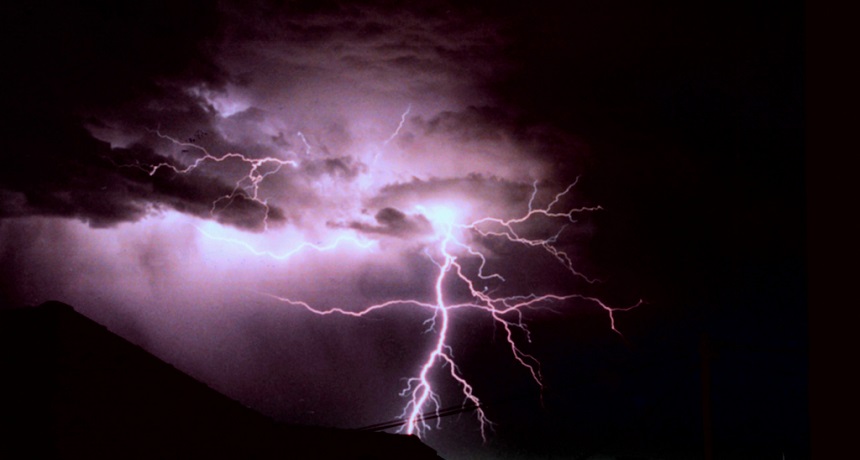Mornings become electric
New study of lightning in the United States suggests that the most powerful strikes occur before noon

Lightning puts on a dramatic light show at night, but the most powerful strikes occur in the morning, a new study finds.
Shane Lear/NOAA Photo Library/Flickr (CC-BY 2.0)
Morning thunderstorms can really pack a punch. Cloud-to-ground lightning reaches its electrical peak across the continental United States around breakfast time, new research shows. Individual lightning strikes deliver more electric charge to the ground between 6 a.m. and 9 a.m. than they do later in the day.
This study shows “when and how strong these things strike,” says Ron Holle. Such information helps researchers find the best strategies for keeping people safe. Holle did not work on the new study. But he certainly knows the field. This meteorologist has studied lightning strikes and lightning safety for more than two decades. He works with Vaisala, Inc., a company that develops and sells tools used to monitor the environment.
Satellite data indicate that lightning hits the ground about three million times each day. People who work or play outside may not know when they’re in danger. And lightning can be deadly. Last year, more than two dozen people in the United States died after being struck by lightning.
The strongest lightning shows up in the morning. Yet that’s not when the most strikes occur. Patterns vary across different regions, but recent studies suggest about two of every three strikes occur between noon and 6 p.m., says Holle. That means students may be particularly vulnerable. “That’s when school gets out and sports leagues begin practicing,” he notes.
Themis Chronis led the new study. An atmospheric scientist, he works at the University of Alabama in Huntsville. He and his international team analyzed 11 years of lightning data collected by the U.S. National Lightning Detection Network. Since the late 1980s, its sensors have been recording where and when lightning strikes.
Focusing on lightning activity in the continental United States, Chronis and his colleagues charted how the electric currents associated with lightning changes throughout the day. Current is the flow of moving electrons, or negatively charged particles. Electricity is another name for that flowing current.
Patterns of lightning activity (the number of flashes) vary from region to region, the researchers found. That’s similar to the results of earlier studies. But something surprising did turn up.
Chronis had expected that when there is a lot of lightning, each strike would be weaker than at times when there is only a little lightning. That’s because each lightning strike shuttles an electric charge to the ground that had been accumulating in its cloud. So a lot of strikes may lead to an electrifying competition. As one strike siphons off charge, less is left for future lightning bolts.
Some regions did show that relationship. Overall, however, that hypothesis didn’t pan out, Chronis now reports.
“It didn’t hold true for the entire day,” he says. Lightning hit its power peak at the same time in every place, no matter when the most flashes occurred. His team published its new findings January 29 in the Journal of Geophysical Research: Atmospheres.
Now Themis is trying to determine why lightning’s power peaks early in the day. He suspects it has something to do with heat from the sun. The most powerful lightning consistently shows up in the one or two hours after sunrise. And scientists know that the sun plays a critical role in the formation of lightning. It heats the wet air that rises to form the clouds that produce lightning.
“We tend to forget that the main driving force behind lightning is the sun,” he says.
Power Words
(for more about Power Words, click here)
atmosphere The envelope of gases surrounding Earth or another planet.
electric charge The physical property responsible for electric force; it can be negative or positive.
electric current A flow of charge, called electricity, usually from the movement of negatively charged particles, called electrons.
electron A negatively charged particle, usually found orbiting the outer regions of an atom; also, the carrier of electricity within solids.
geophysics The study of matter and energy on Earth and how they interact.
hypothesis A proposed explanation for a phenomenon. In science, a hypothesis is an idea that must be rigorously tested before it is accepted or rejected.
lightning A flash of light triggered by the discharge of electricity that occurs between clouds or between a cloud and something on Earth’s surface. The electrical current can cause a flash heating of the air, which can create a sharp crack of thunder.
meteorologist Someone who studies weather and climate events.
particle A minute amount of something.
satellite A moon orbiting a planet or a vehicle or other manufactured object that orbits some celestial body in space.
sensor A device that picks up information on physical or chemical conditions — such as temperature, barometric pressure, salinity, humidity, pH, light intensity or radiation — and stores or broadcasts that information. Scientists and engineers often rely on sensors to inform them of conditions that may change over time or that exist far from where a researcher can measure them directly.
sun The star at the center of Earth’s solar system. It’s an average size star about 26,000 light-years from the center of the Milky Way galaxy.







